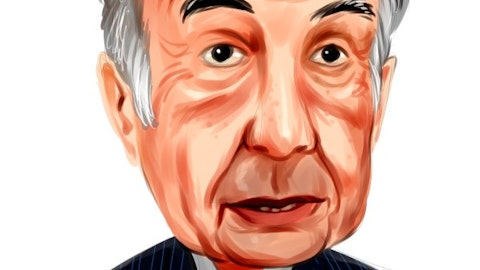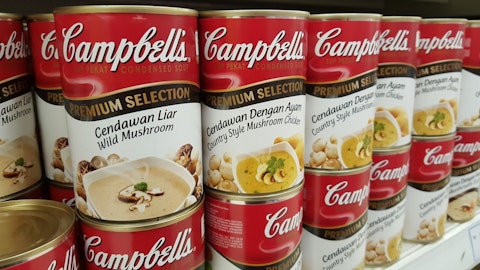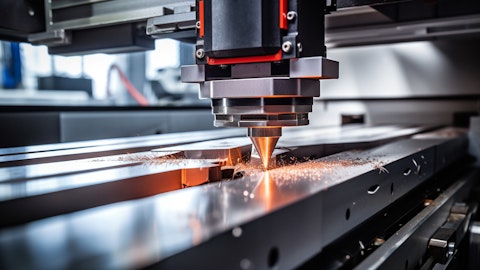Crown Holdings, Inc. (NYSE:CCK) Q4 2023 Earnings Call Transcript February 6, 2024
Crown Holdings, Inc. isn’t one of the 30 most popular stocks among hedge funds at the end of the third quarter (see the details here).
Operator: Good morning and welcome to Crown Holdings’ Fourth Quarter 2023 Conference Call. [Operator Instructions] Please be advised that this conference is being recorded. I would now like to turn the call over to Mr. Kevin Clothier, Senior Vice President and Chief Financial Officer. Sir, you may begin.
Kevin Clothier: Thank you, Bill and good morning. With me on today’s call is Tim Donahue, President and Chief Executive Officer. If you don’t already have the earnings release, it’s available on our website at crowncork.com. On this call, as in the earnings release, we will be making a number of forward-looking statements. Actual results could vary materially from such statements. Additional information concerning factors that could cause actual results to vary is contained in the press release and in our SEC filings, including our Form 10-K for 2022 and subsequent filings. Earnings for the quarter were $0.27 per share compared to $0.74 per share in the prior year quarter. Adjusted earnings were $1.24 compared to $1.17 in the prior year quarter.
Net sales in the quarter benefited from 5% higher volumes in North American beverage, which were offset by the pass-through of lower raw material costs and lower volumes across most other businesses. Segment income was $382 million in the quarter compared to $292 million in the prior year, reflecting higher beverage can volumes in Americas Beverage, the contractual recovery of prior year’s inflationary cost in European beverage more than offsetting the underabsorption of fixed costs. During the quarter, the company decided to optimize its footprint in certain markets and closed a beverage can plant in Batesville, Mississippi, an aerosols plant in Decatur, Illinois, beverage can plants in Ho Chi Minh City, Vietnam, and Singapore. These actions were necessary to align supply and demand and will lead to greater utilization, operational efficiencies and fixed cost absorption.
For the year, the company delivered record adjusted EBITDA of $1.882 billion, an 8% improvement compared to the $1.744 billion in 2022. The improvement was driven by a 4% overall volume growth in Americas Beverage, the contractual recovery of prior year’s inflationary cost in European Beverage, and cost saving initiatives in Transit Packaging. The company achieved $661 million of free cash flow in ‘23, driven by record EBITDA, exceptional working capital management that also included the reduction of approximately $200 million in off-balance sheet factoring, and a continued disciplined approach to capital spending. For 2024, we see EBITDA in line with the 2023 record performance as continued strong performance in North American Beverage and Transit Packaging were offset by lower results in the can-making equipment and aerosol businesses due to lower demand.
As stated in the earnings release, first quarter adjusted earnings per diluted shares are projected to be in a range of $0.90 to $1, with the full year projected to be $5.80 – in the range of $5.80 to $6.20 per share. The adjusted earnings guidance includes net interest expense of $380 million. It assumes average common shares outstanding of approximately 120 million shares, with an exchange rate at current levels with the euro at 1.08 to the dollar; full year tax rate of approximately 25%; depreciation of approximately $320 million; non-controlling interest to be in the range of $130 million; and dividends to non-controlling interests are expected to be approximately $110 million. We currently estimate 2024 full year adjusted free cash flow to be in the range of $700 million to $750 million, with no more than $500 million in capital spending.
At the end of ‘24, we would expect net leverage to be at the lower end of our targeted leverage range of 3.0x to 3.5x. With that, I will turn the call over to Tim.

Tim Donahue: Thank you, Kevin and good morning to everyone. As reflected in last night’s earnings release and as Kevin just reviewed, operating performance in the fourth quarter was well ahead of the prior year’s fourth quarter. Beverage can volumes remained strong in North America and Brazil, offsetting demand weakness in Europe and Asia. Cash flow performance was well above the prior year and earlier expectations, as we significantly adjusted production schedules to drive down working capital. As has been the case throughout the year, below the line items, that is, interest expense, pension and equity earnings, were all negative to prior year. In total, earnings ahead of last year, but short of prior expectations due mainly to a higher tax rate and lower equity earnings.
As Kevin noted, a record EBITDA performance for the company in 2023, with double-digit segment percentage gains found among the three largest businesses, Americas and European Beverage and Transit Packaging more than offsetting headwinds faced from the 2022 steel repricing and weak aerosol can demand. Also, as Kevin noted, during the fourth quarter, we made the decision to close 5 production facilities globally based on our installed capacity, including newer facilities which continue to progress through learning curve and our view of future market growth and demand. Difficult decisions, but necessary to adjust our cost structure with expected future demand. Looking ahead to ‘24, in Americas Beverage, we expect another year of volume growth in North America and Brazil, although that will be somewhat offset by the glass business in Mexico.
After 2 strong years of returnable glass shipments, we project a mix change to more one-way glass, combined with the timing lag for our glass PPI adjustment. In Europe, shipments were down mid-teens in the fourth quarter, with our shortfall compared to the market being the result of our weighting more towards Southern Europe versus Northern Europe. We do expect a flatter demand environment in 2024 and projected income in the segment will return to 2021 levels. As provided in last night’s release, we recast European corporate costs from Corporate and Other to the European Beverage segment. Post the sale of the European tinplate business and completion of all associated service agreements, all remaining costs relate to the European Beverage business.
And as you can deduce from the table, it is $5 million to $6 million per quarter, totaling $21 million for 2022 and $22 million for 2023. Volume softness was noted across each Asian country we operate in as the region continues to struggle with the effects of inflation, which have led to higher base cost levels against declining consumer purchasing power. For 2024, income is projected to be in line with 2023 as cost reductions offset continuing demand weakness. Transit Packaging realized the benefits of significant cost savings in 2023, leading to their highest ever income performance despite a muted industrial backdrop. Free cash in the segment was again strong, with more than $300 million being generated on an unlevered basis. Income growth is again forecast for the segment in 2024, albeit weighted towards the back half of the year.
And the business has a cost structure that positions well for further growth when industrial activity accelerates in the future. Across our non-reportable businesses, income is forecast to be down in 2024 versus 2023, the result of continuing weak aerosol can demand and a significant slowdown in orders for new beverage can manufacturing equipment. As you may recall, in the first quarter of 2023, we initiated a downsizing of the beverage equipment business in response to slowing demand for can manufacturing equipment. The North American food business, with income above pre-pandemic levels, is well capitalized and continues to experience growth in the pet food category. Operationally, 2023 was a strong year, with segment income up more than $100 million.
We generated significant free cash flow, with deleveraging on plan to the lower end of our targeted range. The higher interest rate environment led to significant headwinds below the line in the form of higher interest and pension costs and lower equity earnings. We did take significant action to right-size production capacity in both the U.S. and Asia given our view of market demand, which will lead to higher utilizations near term while allowing for the company to meet future demand growth as new plants progress through learning curve. Looking ahead to 2024, segment income is projected to be in line with 2023 as continued growth in beverage and transit will offset headwinds in aerosols and equipment. We remain focused on operational improvements, generating cash from the businesses and further strengthening the balance sheet, positioning the company well for future growth.
Before we open the call to questions, we just ask that you limit yourselves to two questions so that everybody has an opportunity in the time allotted. And with that, Bill, we are now ready to open the call to questions.
See also 12 Most Advanced AI Assistants and 24 States With Gas Prices Below $3.
Q&A Session
Follow Crown Holdings Inc. (NYSE:CCK)
Follow Crown Holdings Inc. (NYSE:CCK)
Operator: Thank you. [Operator Instructions] We have the first question coming from the line of George Staphos of Bank of America. Your line is now open.
George Staphos: Thanks. Hi, everyone. Good morning. Tim thanks for the details. Same to you, Kevin.
Tim Donahue: George, you can speak up a little?
George Staphos: Yes. Sure. Can you hear me okay now?
Tim Donahue: Yes.
George Staphos: Okay. Sorry about that. Again, thanks for all the details. My two questions. First of all, is there any carryover into 2024 from higher inventory that you need to still work down and/or any kind of inventory charge on steel? That’s question number one. Question number two, Tim, obviously, quarters come and go. Sometimes some segments do better than others. As you look at the non-beverage segments, what makes you still comfortable with the portfolio as it’s aligned? And why do you think the tinplate businesses, machinery and transit can be drivers of earnings as you are seeing in Americas Beverage or maybe rethinking things as we sit here today? Thank you and good luck in the quarter.
Tim Donahue: Sure, George. So, the answer to the first question, no, no carryover. Inventory is pretty much in line with where we think the business is going to go going forward in the tinplate businesses. To your second question, listen, I think the answer is any business is for sale under the right terms and conditions. But we are not in the market to give our businesses away in the hopes of driving some short-term multiple gain just so the private equity guys can make money, because we sold a business it below where it’s value, where the true value is. These businesses all generate pretty substantial cash. I mean, pretty difficult – I have a difficult time understanding how we create more value by getting smaller. We sold a business a couple of years ago, a very large business.
We got a very good price, especially historically when you consider where a food can business trades, didn’t move the needle on valuation. So I have a hard time understanding it. Now specifically to the business as you mentioned, listen, transit is an excellent business. We don’t spend a lot of time talking about it because you folks don’t want to talk about it, but this is a business with low- to mid-teens margins that requires almost no capital investment. I wish I had 5 more businesses like this where I didn’t have to invest any money and all it did was send me cash every day. Pretty stable business. Some of the end markets, as we’ve said before, might not be as stable or they might fluctuate more than other businesses. But our business, servicing a variety of end markets, is remarkably stable with the exception of the COVID year.
The tinplate businesses, the food business is, as we said, well capitalized, doing quite well, income above pre-pandemic levels. Aerosol, well, it is an expensive way to dispense products. There are some things happening in the aerosol market. I would say that some of the large CPGs, despite their claims to meet their environmental goals, if you were to go into a market, you’d see that a lot of air fresheners now are in all plastic. They are not in metal anymore. They are not an aluminum and/or steel. So it is a changing business. We’re going to right-size the business for what we expect future demand to be, and we’ll see where it goes from there. The beverage can equipment business, it’s been an excellent business for us for a number of years.
I would project that this year and next year that it’s predominantly a service and parts business, that there is – there are a few new machine orders or new lines being installed globally, with the exception of China. And so we’ll hold on. We’ve right-sized the business. We’ll see what other end markets that our skilled technicians and mechanics can serve us besides beverage can equipment. But this is – this is a charge we took in the first quarter last year, George, and I won’t say which analyst, but one of you analysts called me afterwards and said, this is kind of the canary in the coal mine. You talked about your beverage can equipment business taking a big charge because of reduced expected demand and nobody brought up the question, as if nobody wanted to understand what was going on with expected future growth in beverage.
And so I’ll leave that answer to a future question. But that’s my longwinded answer to your question, George. I apologize for being so long.
George Staphos: No, Tim, not at all. We appreciate the thoughts. We’ll turn it over. And thanks and good luck in the quarter.
Tim Donahue: Thank you.
Operator: Thank you. We will move now to the next question coming from the line of Phil Ng of Jefferies. Your line is now open.
Phil Ng: Hey, guys. 1Q earnings EPS is a big step down. And if I look at your full year guidance, it seems to be more front-end loaded in terms of headwinds. Tim, can you kind of flesh out some of the things that might be weighing on your results in the early parts of the year versus hopefully the later part of the year, if maybe any other good guides that could kind of kick in?
Tim Donahue: Yes. I think that – again, our guidance versus your estimates, these were your estimates, not ours. And I understand your estimate for Q1 was trying to somewhat move from what we reported in the first quarter of ‘23 back towards the first quarter of ‘22 and we’re going the opposite direction. I would say that European Beverage, probably a bit weaker in Q1 than we would have or you would have anticipated, and that’s largely the result of Q1 being a smaller quarter and – and while we do expect the European market to pick up in ‘24, we would expect that to be more back – more summer weighted, not Q1. And then the other segments, we had a very strong result in the equipment business in Q1 last year, and I’ll bet you if I had numbers in front of me, I’ll bet you our equipment businesses, probably down in the order of $10 million to $12 million alone, Q1 ‘24 versus Q1 ‘23.
And then aerosol probably makes up another handful of the shortfall. So they would be the three buckets.
Phil Ng: Okay. And then can you give us a little more color on what’s going on in Europe? Certainly, it’s well telegraphed, Europe has been soft. Where are things right now? I mean, is inventory really already flushed out in Europe? Are you starting to see any green shoots in terms of order patterns with your customers in Europe? And I guess one follow on. On the D&A side, you guys talked about potentially a 36 tailwind. Is that in the guide already? Or is that something that…
Tim Donahue: No, it’s in the guide already.
Phil Ng: Okay, it’s in the guide already.
Tim Donahue: So I think in Europe, as I said in the prepared remarks, we are much stronger in Southern Europe than we are in Northern Europe. So if you want to think about Spain, Italy, Greece. And those markets were significantly weaker than the Northern European markets. We actually did quite well in the Middle East and Turkey, but our weakness was in the Southern Continental European countries. I think that there are some things in the European market that are certainly different from a retail perspective and a customer promotion perspective than – than what we see in North America. And – but I do think Europe is a market that will grow this year. It’s a market that might be down 1 year, but it doesn’t stay down for long.
It generally – if we have a down year in Europe, we generally bounce back pretty quick within a year, not much more than a year. So I do expect Europe – although weak Q1, we’re projecting to be weak, I do expect some strength beginning in Q2 and forward.
Phil Ng: Have you seen order patterns and inventory get flushed down the channel at this point, like orders pick up or still too early to call?
Tim Donahue: No, I think it’s still too early for that.
Phil Ng: Okay, appreciate the color, Tim.
Tim Donahue: You are welcome.
Operator: Thank you. We will now move to the next question coming from the line of Mike Roxland of Truist Securities. Your line is open.
Mike Roxland: Hi, thank you, Tim, Kevin and Tom for taking my questions. Just wanted to follow-up on the last one that have been asked about Europe, especially as it relates to some of these retailers, that Carrefour would stop selling Pepsi and 7UP given unacceptable price increases. We’ve been hearing that other retailers are doing the same. Has that impacted demand in Europe? And do you explore – and if it has, do you expect it to impact demand in Europe if an agreement can’t be reached between these retailers and CPGs?




